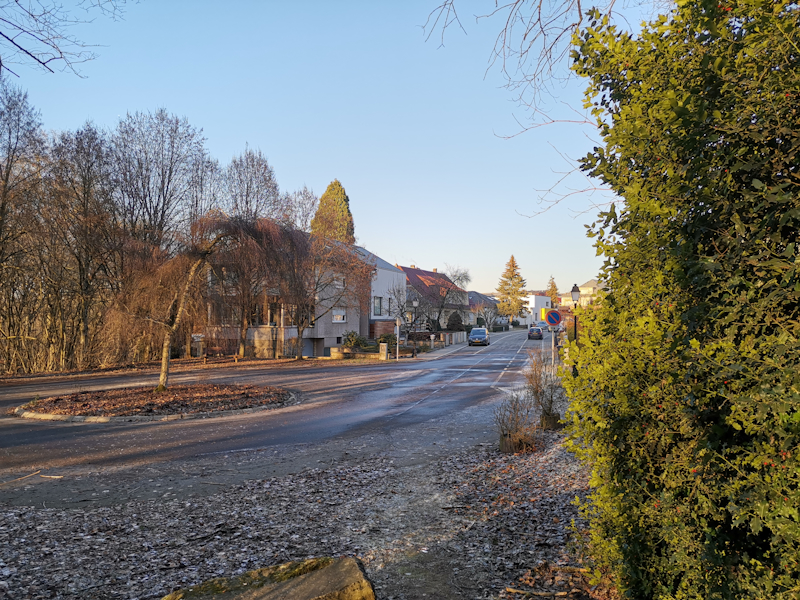Honor Launches The View20: A 48MP Camera Review
by Andrei Frumusanu on January 28, 2019 8:00 AM EST- Posted in
- Smartphones
- Mobile
- Kirin 980
- Honor View20
Camera - Daylight Evaluation
While this isn’t a full review, the one aspect of the View20 that I definitely wanted to cover for the launch embargo is the new camera. Honor makes a lot of promises for the View20, an in particular there’s a new “AI Ultra Clarity” mode which promises to improve detail retention in the full 48MP mode in bright lightning conditions.

[ Honor View20 ] - [ Mate 20 Pro ]
[ Galaxy Note9 ] - [ Galaxy S9+ ] - [ LG V40 ]
[ OnePlus 6T ] - [ Pixel 3 ]
In the first scene, the View20 in its default 12MP capture mode performed very well and does look like it represents an increase in detail over the Mate 20 Pro’s 10MP mode. Dynamic range processing between these two devices looks to be very similar, although I do feel they both are too warm and not as realistic as some other the competition phones.
In 48MP mode, we see some of the inherent disadvantages of the sensor as similar results to last year’s 40MP units from Huawei: the picture unfortunately loses out in dynamic range and this is particularly visible in the darker and less detailed shadows. The shadows in the View20 are darker than the Mate 20 Pro, however the highlights on the View20 are more pronounced. Another difference in the new sensor is seemingly better detail retention on textures, pointing out to better DTI of the new sensor. While textures are improved on the View20, one aspect where it does clearly lag behind is in the clarity of the branches of the tree. I think this could point out to a worse quality lens on the part of the View20 as it does looks like a typical case of chromatic aberration.
Using the AI Clear mode (“Clear mode” from here on forth) we see the picture regain some of the dynamic range that was lost by using the 48MP mode. While this was an improvement, the detail in this scene suffered tremendously as we see a heavy noise filter on the whole image just blur out details in an indiscriminate fashion, making this a huge miss for this mode in this first scene. I’m not sure what happened here, it could be that the firmware still has some bugs as under closer inspection it does look more like a 12MP result even though the phone was set to 48MP clear mode.

[ Honor View20 ] - [ Mate 20 Pro ]
[ Mate 20 ] - [ Galaxy Note9 ] - [ Galaxy S9+ ]
[ LG V40 ] - [ OnePlus 6T ] - [ Pixel 3 ]
In the second scene, we have a quite different result compared to the first shots. In 12MP mode again the processing was extremely similar to the Mate 20 Pro’s 10MP mode, with just a slight advantage in detail for the new phone. While on paper this 12MP mode should be somewhat equal or actually even superior to other 12MP phones, it’s actually not the case as the phone still trails the effective spatial resolution produced by the Note9.
Switching over to 48MP mode, the View20 now actually leads in terms of resolved detail. Here again it’s visible that the new sensor is a definitive upgrade compared to the 40MP unit in the Mate 20 Pro.
Turning on clear mode again, we now actually see a big beneficial effect on the picture quality as the resulting image has better dynamic range and also its detail retention is overall improved in the whole of the shot. The resulting shot is definitely leagues ahead of any other phone in terms of sheer detail, although it comes at a cost of reduced dynamic range and shadows.

[ Honor View20 ] - [ Mate 20 Pro ]
[ Mate 20 ] - [ Galaxy Note9 ] - [ Galaxy S9+ ]
[ OnePlus 6T ] - [ Pixel 3 ]
The in the next tree stump shot, between the 12MP and 48MP clear mode shots, the exposure and resulting dynamic range of both shots are virtually indistinguishable. Under closer inspection, this again looks to be a dud shot for some reason as the 48MP clear mode shot doesn’t actually have any better spatial resolution than the 12MP shot, a similar result to our first scene.
Clear mode aside for now, the normal 48MP shot has some fantastic level of detail, again showcasing the much better DTI compared to its 40MP brethren in the Mate 20 Pro.
Finally back in the 12MP mode, the View20 showcases exemplary dynamic range, although again it loses out in terms of detail compared to say the Note9 or OnePlus 6T.

[ Honor View20 ] - [ Mate 20 Pro ] - [ Mate 20 ]
[ Galaxy Note9 ] - [ Galaxy S9+ ] - [ LG V40 ] - [ OnePlus 6T ] - [ Pixel 3 ]
In a similar scene, but this time with the sun more brightly lighting up details, we see the clear mode again actually be useful as it’s able to better retain details throughout the scene. At this focal distance, we again see some issues compared to the result of the Mate 20 Pro; the latter image is again much sharper and the type of blurriness we’re seeing is again what one would traditionally attribute to lesser quality optics.
This detriment isn’t nearly as visible in 12MP mode, and here the View20 showcases again excellent dynamic range as probably the best exposed results among the tested smartphones.

[ Honor View20 ] - [ Mate 20 Pro ] - [ Mate 20 ]
[ Galaxy Note9 ] - [ Galaxy S9+ ] - [ LG V40 ] - [ OnePlus 6T ] - [ Pixel 3 ]
This last scene is quite harsh in terms of the dynamic range requirements. Nevertheless, the 12MP mode of the View20 manages to breeze through this aspect of the shot, taking full advantage of the characteristics of the quad-bayer sensor setup.
The 48MP mode in this shot is a good showcase how the sensor loses out in dynamic range when using its “full resolution”. Clear mode here does manage to regain some of the dynamic range back, and again for this scene we see a beneficial effect on details.
It’s an improvement, but high MP sensors still aren’t worth the double-edged sword
My experience with the View20 and the new IMX586 sensor pretty much mirror what I’ve come to experience with the 40MP sensors of the P20 Pro and Mate 20 Pro. The high megapixel count can definitely be useful to resolve more detail at a micro level of a picture, however these capture modes come with a big double edged sword side-effect of much worse dynamic range at the macro level of a picture.
In every-day use-cases, I don’t recommend using the 48MP modes of the View20, as much as on the P20 Pro and Mate 20 Pro, it comes with too many compromises. Huawei defaults its settings to 10MP on its phones, and this makes sense. Honor on the View20 also defaults to 12MP mode, however the inclusion of its new 48MP “AI Ultra Clear” mode complicates things for the users as it’s not exactly clear which mode is better to use. First of all, as seen in several scenes here today, the clear mode seems to be buggy and resulting in 12MP quality pictures even though the output image is 48MP in resolution. More important than this, and even though the clear mode does improve on this, the loss in dynamic range remains disappointingly big, which can cause for bad images in challenging capture scenarios.
The View20’s sensor does look like a straight improvement over the 40MP unit on the P20 Pro and Mate 20 Pro – however it’s also seemingly clear that the new phone doesn’t have as good optics as the Huawei flagships. Here it does look like the Huawei’s counterparts Leica optics actually are actually worth their marketing promises.
What the View20’s camera ends up in low-light is as an excellent 12MP shooter with great exposure and dynamic range characteristics. It’s not going to win in terms of detail, but it’s sufficiently good enough that it shouldn’t represent a deal-breaker. Overall though I do wish we’d see Huawei or Honor employ a top-range low MP sensor in their phones and measure such as setup again competing flagships.










37 Comments
View All Comments
philehidiot - Wednesday, January 30, 2019 - link
You'd be amazed when you go back to old phones with older sensors. I found a dick pic from about 4 or 5 years ago and you'd be amazed at how grainy and small it looked with the optical distortion. Only goes to show how much effort they've put into the lenses and how things incrementally improve over time.That's if you see grey hair as an improvement, that is.
phoenix_rizzen - Saturday, February 2, 2019 - link
Would be nice to have more than 3x optical zoom, too.Will be interesting to see results from the OPPO? phone with motors and extra horizontal lenses too see how their 10x zoom results look.
phoenix_rizzen - Saturday, February 2, 2019 - link
motors == mirrorsStormyParis - Monday, January 28, 2019 - link
Very interesting and insightful, thank you.I'm wondering how all those fancy AI-, Night-, ... modes deal with moving objects since they all seem based on some kind of HDR.
Andrei Frumusanu - Monday, January 28, 2019 - link
They take up to 4 seconds to capture so they're no good with moving objects.eastcoast_pete - Monday, January 28, 2019 - link
@Andrei: Thanks for this review. Did I get it correct - the 40 MP are more virtual than actual? I am curious how the Sony "40 MP" sensor compares to the very large 40 MP sensor in the Nokia Pureview 808. That sensor was a beast, and didn't just have 40 actual Megapixels, but also on-chip 4-in-1 binning. Any comments? Whatever happened to that sensor?Lastly, for any manufacturer who might read this: As somebody who really looks for a good camera in my phones, I for one don't mind a notable hump for the camera if (IF) you make it worth it in the photo and video quality.
eastcoast_pete - Monday, January 28, 2019 - link
Okay, I think I answered my own question: yes, the Sony chip is a "virtual" 40 MP, but that comes at a cost, mainly in form of really small imaging pixel size. I also took another look at the 41 megapixel Pureview sensor that Nokia's 808 featured: pixel size: 1.4 µm; 7728x5368 actual (not virtual) pixels, and a sensor size of 10.67 × 8.00 mm. When it came out, it monstered pretty much any compact fixed lens camera with better details and overall picture quality. I would love to see something similar in a smartphone with modern tech (Snapdragon 855 or Kirin 980), Android 9+, and BSI instead of FSI. For that, I take the big hump any day. Anybody else who'd be interested in that kind of kit?serendip - Monday, January 28, 2019 - link
I still have an 808 that gets used on sunny days. That said, my cheap Xiaomi phones have much better overall photo quality with Google Camera's HDR. The 808 has lovely detail rendering, almost like a Micro 4/3 sensor, but dynamic range is lacking and noise is terrible.Now someone needs to take that big sensor and marry it with a fast GPU and IP. Microsoft tried this with the Lumia 1020 but the SoC in that was too slow. A new Snapdragon 855 should be perfect for this.
tuxRoller - Friday, February 1, 2019 - link
Here's a comparison with the lumiawww.androidauthority.com/huawei-mate-20-pro-vs-nokia-1020-924642/
jjj - Monday, January 28, 2019 - link
Would be nice if you could also camera review the Xiaomi Redmi Note 7, just to see the differences between this and a 150$ phone.